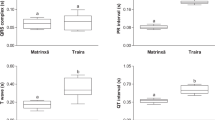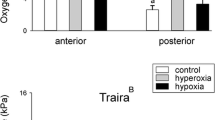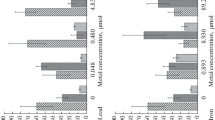Abstract
The trochid snail Monodonta articulata Lamarck was exposed to mercuric sulphate at concentrations of 0.2, 0.5, 0.8 and 1 ppm Hg++. At 24 h, retraction into the shell was observed in 0.8 and 1 ppm Hg++; this retraction increased in these concentrations at 36 h. Retracted snails died if retained in the solutions, but generally recovered within 24 to 48 h if transferred to uncontaminated sea water. Immersionemersion behaviour and interface activity were studied over 24 h by means of an aktograph; snails in normal sea water spent more time below than above the water surface, and exhibited frequent periods of activity. Exposure to mercuric sulphate at concentration of 0.25, 0.5, 0.8 and 1 ppm Hg++ progressively reduced both the length and frequency of activity periods. From 0.5 ppm Hg++ upwards, emersion periods increased, and immersion periods decreased. Oxygen consumption of snails was measured in sea water and in mercuric sulphate at concentrations of 0.2, 0.5, 0.8 and 1 ppm Hg++. Oxygen consumption decreased significantly with each progressive rise in mercury concentration. It is considered that mercury affects M. articulata by interfering with respiration, initially reducing interface activity, then forcing the snail for longer and longer periods out of the water. Retraction occurs when activity is no longer possible. It is concluded that respiratory and behavioural alterations of this nature would afford a good indicator of the presence of sub-lethal concentrations of pollutants.
Similar content being viewed by others
Literature Cited
Ansell, A.D.: Oxygen consumption by the bivalve Donax vittatus (da Costa). J. exp. mar. Biol. Ecol. 11, 311–328 (1973)
Bond, H. and N.O. Nolan: Results of laboratory screening tests of chemical compounds for molluscicidal activity. 2. Compounds of mercury. Am. J. trop. Med. Hyg. 3, 187–190 (1954)
Chandler, A.C.: Control of fluke disease by destruction of the intermediate host. J. agric. Res. 20, 193–208 (1920)
Clarke, G.L.: Poisoning and recovery in barnacles and molluscs. Biol. Bull. mar. biol. Lab., Woods Hole 92, 73–91 (1947)
De Coursey, P.J. and W.B. Vernberg: Effect of mercury on survival, metabolism and behaviour of larval Uca pugilator (Brachyura). Oikos 23, 241–247 (1972)
Evans, F. and H. Micallef: The marine fauna of Malta, 26 pp. Malta: University Press 1968
Hargrave, B.T. and C.P. Newcombe: Crawling and respiration as indices of sublethal effects of oil and a dispersant on an intertidal snail, Littorina littorea. J. Fish. Res. Bd Can. 30, 1789–1792 (1973)
Harry, H.W. and D.V. Aldrich: The distress syndrome in Taphius glabratus (Say) as a reaction to toxic concentrations of inorganic ions. Malacologia 1, 283–289 (1963)
Keckes, S. and J.K. Miettinen: Mercury as a marine pollutant. In: Marine pollution and sea life, pp 276–289. Ed. by M. Ruivo. London: Fishing News (Books) Ltd. 1972
McInnes, J.R. and F.P. Thurberg: Effects of metals on the behaviour and oxygen consumption of the mud snail. Mar. Pollut. Bull. 4, 185–187 (1973)
McMullen, D.B.: Schistosomiasis and molluscicides. Am. J. trop. Med. Hyg. 1, 671–679 (1952)
Micallef, H.: A further study of the activity of Monodonta lineata (da Costa) by means of an aktograph. Rev. roum. Biol. (Sér. Zool.) 16, 51–57 (1971)
— and W.H. Bannister: Aerial and aquatic oxygen consumption of Monodonta turbinata (Mollusca: Gastropoda). J. Zool., Lond. 151, 479–482 (1967)
Skidmore, J.F.: Respiration and osmoregulation in rainbow trout with gills damaged by zinc sulphate. J. exp. Biol. 52, 481–494 (1970)
Sprague, J.B.: Measurement of pollutant toxicity to fish. — III. Sublethal effects and “safe” concentrations. Wat. Res. 5, 245–266 (1971)
Strickland, J.D.H. and T.R. Parsons: A practical handbook of seawater analysis. Bull. Fish. Res. Bd Can. 167, 1–311 (1968)
Szumlewicz, A.-P. e H. Kemp: Moluscocidas promissores contra un caramujo planorbides brasileiro. Revta bras. Malar. Doenç. trop. 3, 389–406 (1951)
Thurberg, F.P., M.A. Dawson and R.S. Collier: Effects of copper and cadmium on osmoregulation and oxygen consumption in two species of estuarine crabs. Mar. Biol. 23, 171–175 (1973)
Vernberg, W. and J. Vernberg: The synergistic effects of temperature, salinity and mercury on survival and metabolism of the adult fiddler crab, Uca pugilator. Fish. Bull. U.S. 70, 415–420 (1972)
Wisely, B. and R.A.P. Blick: Mortality of marine invertebrate larvae in mercury, copper and zinc solutions. Aust. J. mar. Freshwat. Res. 18, 63–72 (1967)
Author information
Authors and Affiliations
Additional information
Communicated by J.H.S. Blaxter, Oban
Rights and permissions
About this article
Cite this article
Saliba, L.J., Vella, M.G. Effects of mercury on the behaviour and oxygen consumption of Monodonta articulata . Mar. Biol. 43, 277–282 (1977). https://doi.org/10.1007/BF00402320
Accepted:
Issue Date:
DOI: https://doi.org/10.1007/BF00402320




